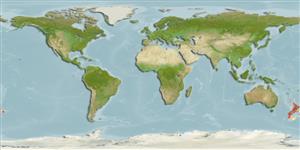Pycnogonida |
Pantopoda |
Phoxichilidiidae
Environment: milieu / climate zone / djupintervall / distribution range
Ekologi
; djupintervall 0 - 400 m (Ref. 9). Temperate
Southwest Pacific: New Zealand.
Length at first maturity / Size / Weight / Age
Könsmognad: Lm ? range ? - ? cm
Males usually have more setae, increasing in numbers distally. The abdomen sometimes lacks strong spines near its tip (broken off ?), and the strong spines at midfemur length are sometimes small or even absent. The tibiae sometimes have rather dense lateral and dorsal setae but some specimens have far fewer setae on these segments (Ref. 9).
North and South Islands from littoral depths to 400 m (Ref. 9).
Life cycle and mating behavior
Könsmognad | Reproduktion | Lek | Eggs | Fecundity | Larvae
Members of the class Pycnogonida are gonochoric and sexually dimorphic. During copulation, male usually suspends itself beneath the female. Fertilization occurs as the eggs leave the female's ovigers. Males brood the egg masses until they hatch. Life cycle: Eggs hatch into protonymphon larva then to adults.
Child, C.A. 1998 The marine fauna of New Zealand: Pycnogonida (sea spiders). NIWA Biodiversity Memoire 109. National Institute of Water and Atmospheric Research (NIWA). Washington, D.C. 20530, USA. 71 p. + Figure 2A-G, 3A-F, 4, 5. (Ref. 9)
IUCN Red List Status
(Ref. 130435: Version 2025-1)
CITES status (Ref. 108899)
Not Evaluated
Not Evaluated
Threat to humans
Human uses
| FishSource |
Verktyg
Ytterligare information
Trophic EcologyFood items (preys)
Födosammansättning
Födointag
Predatorer
Population dynamicsTillväxt
Max. ages / sizes
Length-weight rel.
Length-length rel.
Length-frequencies
Mass conversion
Abundans
PhysiologySyreförbrukning
Human RelatedStamps, coins, misc.
Internet-källor
Estimates based on models
Preferred temperature
(Ref.
115969): 7.9 - 16.6, mean 12.7 (based on 82 cells).
Price category
Unknown.
